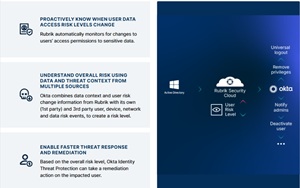Rubrik Announces Immutable Backup for Okta Environments
Rubrik has introduced Okta Recovery, a new capability for backing up and restoring Okta identity data. Separately, Rubrik detailed its integration with Okta Identity Threat Protection, combining Rubrik's data risk insights with Okta AI's user risk signals to automate remediation workflows.
The company described the new service as providing "automated, immutable backups and in-place, granular recovery for critical Okta objects and metadata, enabling organizations to quickly recover from costly disruptions." Rubrik said that while Okta delivers a secure platform, customers are ultimately responsible for managing their own tenant data and configurations. Without a backup and recovery mechanism, IT teams must rebuild or script complex workflows manually if identity data is compromised. The new capability aims to address that risk by giving administrators a faster and more reliable path to restoring access.
Rubrik positions itself as the Security and AI company focused on cyber resilience and recovery, while Okta is a leading independent identity provider.
 [Click on image for larger view.] Okta Identity Threat Protection and Rubrik (source: Rubrik).
[Click on image for larger view.] Okta Identity Threat Protection and Rubrik (source: Rubrik).
Hema Mohan, vice president of Product Management at Rubrik, said, "While organizations are consolidating their identity systems, many are still operating in complex hybrid and multi-IdP environments that create new blind spots when it comes to complete cyber resilience. By protecting the critical configurations and dependencies within Okta, we are empowering our customers to defend identity and data, recover quickly, and build lasting resilience in one simple, yet powerful solution."
Okta Recovery for Identity Resilience
The new Rubrik Okta Recovery provides automated, immutable backups and granular, in-place recovery for Okta environments. IT teams can protect critical Okta objects such as users, groups, applications, and metadata, while restoring them directly in the live tenant if they are misconfigured, compromised, or deleted. Rubrik emphasized that this eliminates the need for time-consuming manual rebuilds or custom workflows. The company said Okta Recovery is expected to be available in the coming months.
Immutable Backups and Faster Restoration
Rubrik's approach centers on operational resilience. Okta Recovery uses Rubrik-owned immutable, air-gapped storage to safeguard identity data from attacks or tampering. Automated and on-demand backups run continuously, and recovery can be performed at a granular level to minimize disruption. The goal is to help organizations reduce downtime and avoid costly identity-related outages from human error, misconfigurations, or malicious activity.
Integration with Okta AI for Threat Protection
Beyond backup and recovery, Rubrik is integrating with Okta Identity Threat Protection powered by Okta AI. Rubrik Security Cloud monitors changes to user access permissions and assigns risk levels based on sensitive data exposure. That data context is combined with Okta's user, device, and network signals to calculate overall user risk. Depending on the assessed level, Okta can trigger automated remediation actions such as universal logout, privilege removal, or forced re-authentication.
Okta then uses this combined context to orchestrate responses. For example:
| Risk Level |
Potential Response |
| Medium |
Send notifications to SIEM or incident response teams |
| High |
Force re-authentication, kill user sessions, or log users out of applications |
Rubrik positioned this integration as a way to "help customers proactively detect changes to users' sensitive data access levels and automate remediation." The company also highlighted its ability to provide "ongoing incremental scanning of data and AD changes" to give organizations visibility into evolving identity risk.
Impact for IT and Cloud Professionals
For IT pros and developers, the Okta-Rubrik partnership highlights a convergence of identity security and operational resilience. Enterprises running hybrid identity infrastructures now gain unified protection that consolidates tooling across AD, Entra ID, and Okta. By pairing air-gapped recovery with AI-driven risk detection and automated remediation, the solution aims to reduce blind spots, minimize manual recovery efforts, and strengthen resilience against both cyberattacks and misconfigurations.
For more information, check out the news release and the Okta Identity Threat Protection and Rubrik solution brief.
About the Author
David Ramel is an editor and writer at Converge 360.